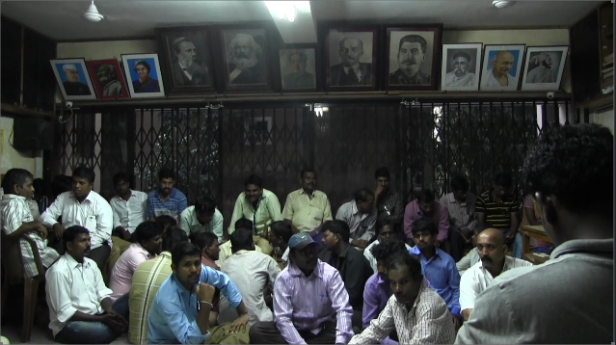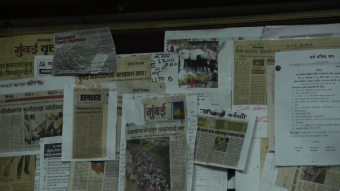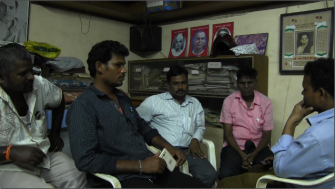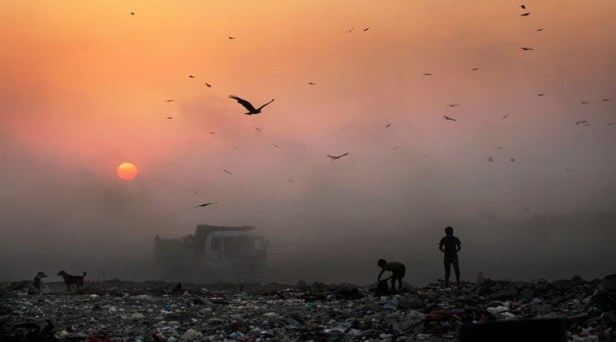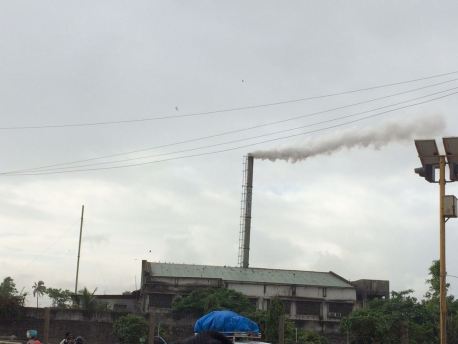The films presented in this section have been produced as part of the Working with Video-II course that is offered to the students of MA in Media and Cultural Studies in the third semester. For the course, the students are expected to take up a theme related to the city of Mumbai and explore it from various perspectives using the video documentary form. Apart from providing additional research, visualisation, writing and video production skills to the students, several workshops are organised to orient them to the chosen theme and connect them to relevant individuals and organisations who could facilitate their efforts in research and production, for what will be their first documentary films.
The underlying idea behind such an approach is to encourage students to engage with the city – its past and present – work with people, collectives, movements and organisations that are working to raise and address questions of dignity and justice, and render the stories that remain untold in a critical and sensitive manner.
On the lines of the WasteLines Mumbai series produced by the class of 2017, several similar projects have been undertaken by the students and faculty members of the School.
These are:
From the Margins Transforming M-East Ward: A set of films and oral history videos from the severely disadvantaged municipal ward in Eastern Mumbai.
Remembering 1992 A set of films and interviews revisiting the city two decades after the violence it experienced in 1992-93.
GiranMumbai Showcasing stories of erasures, lives, livelihoods and spaces from the mill lands of Mumbai.
CasteMopolitan Mumbai Showcasing debates around caste in the city and its pervasiveness in everyday life.
The additional film ‘City’s Edge’ is also an SMCS production made in the year 2011, and is presented on this page as it speaks poignantly to the theme.
WasteLines Mumbai Mumbai – The Film Series
Kapda Kamra Kachra
Directors:
Ajeet Mahale, Bhamini Lakshminarayan, Sandeep S and Ramadas K.S.
Synopsis:
The film documents the lives of a small group of bhaandiwaalis who live on a footpath in Tardeo, Mumbai. Bhaandiwaalis are women who barter utensils for old clothes in middle-class homes, and consequently recycle the old cloth through trade. The film centres around their daily struggles: the struggle for their job, particularly in the context of the neo-liberalised city and their now-limited access to it because of skyscrapers and gated communities; their struggles against poverty, homelessness, and the looming threat of eviction; their struggles to be recognised and be treated as citizens by the state. Through their narratives, the film questions the idea of what, or even who, ‘waste’ is.
Why This Cow-laveri Di?
Directors:
Abir Dasgupta, Sameer Gardner, Adhvaidha K. and Sanghamitra Dutta
Synopsis:
Why This Cow-laveri Di? deals with the discourse around cow and bull slaughter in Maharashtra through a series of interactions with groups across ideological spectrums. Through conversations with gaushala managers (cow welfare trusts), beef traders, academics and government officials, the film follows the story of what people believe must be done when cattle is of no use to the farmer. Given the challenges the country faces, these questions are of paramount importance as the cow holds major significance in the country socially, politically and economically. Through dedicated sections for each of the arguments the film attempts to draw a holistic picture of the ideologies surrounding cow slaughter and also lays bare the nature of the discourse surrounding it. As the sections proceed they interact with each other and piece together the larger picture of Cow politics in India. The pieces are held together by excerpts from mainstream media news reports thus giving the viewer a greater understanding of the context and ramifications of this historically significant debate.
Wo Dhuan
Directors:
Akhil Vasudevan, Ambu G., Amlan J. Das and Tanya Mishra
Synopsis:
The smoke chimney is a testimony to waste disposal, incinerated waste. The smoke chimney is also testimony of increasing pollution. The film Wo Dhuan is a tale of the area of Sathenagar that houses the Mumbai city’s only biomedical waste factory. Through the tales of the residents the film seeks to explore the living conditions around the area, along with the effect of the factory upon residents of Sathenagar. The film is a narrative journey into the concept of waste and waste disposal and how these neat categories often lose their sharp boundaries and become blurred when personal experiences are foregrounded.
Like Dust We Rise
Directors:
Abhimanyu Kumar, Arya A.T., Garima Kaul and Prerna Gupta
Synopsis:
This is a film about those who clean the city of dreams. It brings to the fore, through the narratives of a few BMC workers, the lackadaisical workings of the Bombay Municipal Corporation resulting in injustice to the workers. Kali, Murugan, Anthony, Aziz, Saroja and Rajeshwari carry the narrative forward as they narrate personal incidents of injuries and accidents on field, for which they have not received any compensation. The indifference of the system and its wrongdoings have united all BMC contractual labours into a Union whose fight goes on. This is a film about grit and gumption.
These Women in the Hills
Directors:
Adwaita Banerjee, Amrutha K. P., Pralay Nagrale and Tufail Ahmad Lone
Synopsis:
These Women in the Hills tells the story of not only a few individuals but of the general dynamics within the Deonar Dumping Ground, of who is allowed and who is not allowed to enter. It implicates the city in the process of looking at the way waste work is treated within such a space. The film tries to look at the waste workers and the kind of troubles they go through during their work, questioning the popular middle class notion of it being ‘dirty’. The film broadly tells the story of the situation within the dumping ground, following the fires of early 2016, which left families devastated not only with illness but also with the prospect of loosing one’s only means of livelihood.
Mithi Si
Directors:
Aayushi Bengani, Aparna Srivastava, Milen Mathew John and Pruthviraj Shinde
Synopsis:
The film is a travelogue along the Mithi river. The narrative commences at the start of the Mithi river at Morarji Nagar, and closes at the end of the river at Mahim Bay. The film stops at various points along the river bank, at various locations- Morarji Nagar, Bharat Nagar, Powai, Marol, Mahim. At every stop, a different story emerges from the location, about the river, its past, present, and future. The leitmotif that ties these narratives and the visual narrative is the urban desolation marked by waste accumulation around the river. While we have collected narratives from various people, the major character remains the river; the film speaks of its origin, its forgotten journey through the city, and the overwhelming tragedy of the effects it has on the environment, on the city space and on the health of the city’s biodiversity.
City’s Edge
Directors:
Sandeep Singh, Shweta Radhakrishnan, Sharib Ali, Gin Khan Siam and Abhishek Yadav
Synopsis:
The film is a travelogue along the Mithi river. The narrative commences at the start of the Mithi river at Morarji Nagar, and closes at the end of the river at Mahim Bay. The film stops at various points along the river bank, at various locations- Morarji Nagar, Bharat Nagar, Powai, Marol, Mahim. At every stop, a different story emerges from the location, about the river, its past, present, and future. The leitmotif that ties these narratives and the visual narrative is the urban desolation marked by waste accumulation around the river. While we have collected narratives from various people, the major character remains the river; the film speaks of its origin, its forgotten journey through the city, and the overwhelming tragedy of the effects it has on the environment, on the city space and on the health of the city’s biodiversity.
Duration: 18 mins 41 secs | Language:Hindi | Subtitles: English
